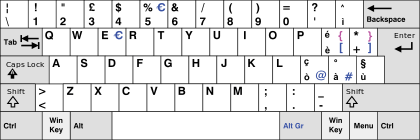Languages of Italy
There are approximately thirty-four native living spoken languages and related dialects in Italy,[6] most of which are largely independent Romance languages. Although they are sometimes colloquially referred to as dialects or regional languages, they are almost all distributed in a continuum across the regions' administrative boundaries, and speakers from one locale within a single region are typically aware of the features distinguishing their own variety from one of the other places nearby.
| Languages of Italy | |
|---|---|
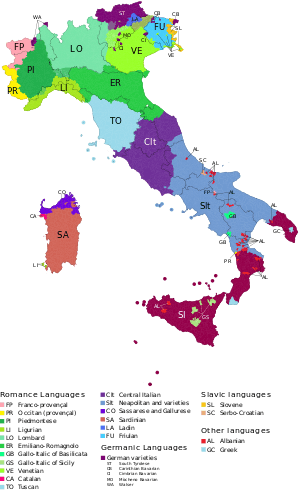 | |
| Official | Italian |
| Regional | see "classification" |
| Minority | see "historical linguistic minorities" |
| Immigrant | Spanish, Albanian, Arabic, Romanian, Hungarian, Polish, Ukrainian, Russian, Bulgarian, and Romani[5] |
| Foreign | |
| Signed | Italian Sign Language |
| Keyboard layout | |
| Source | Special Eurobarometer, Europeans and their Languages, 2006 |
| Part of a series on the |
| Culture of Italy |
|---|
 |
| History |
| People |
| Languages |
| Traditions |
| Cuisine |
| Festivals |
| Religion |
| Art |
| Literature |
|
Music and performing arts |
|
Media |
| Sport |
|
Monuments |
|
| This article is part of the series on the |
| Italian language |
|---|
| History |
| Literature and other |
| Grammar |
| Alphabet |
| Phonology |
The official and most widely spoken language across the country is Italian, a direct descendant of Tuscan. However, in parallel, most Italians also communicate in one of the regional languages that are indigenous evolutions of Vulgar Latin.
Other Italian languages belong to other Indo-European branches, such as Cimbrian, Arbëresh, Slavomolisano and Griko. Other non-indigenous languages are spoken by a substantial percentage of the population due to immigration.[7]
Of the indigenous languages, twelve are officially recognized as linguistic minorities: Albanian, Catalan, German, Greek, Slovene, Croatian, French, Franco-Provençal, Friulian, Ladin, Occitan and Sardinian. However, full bilingualism (bilinguismo perfetto) is legally granted only to German, Slovene and French and enacted in the regions of Trentino Alto-Adige, Friuli Venezia Giulia and the Aosta Valley, respectively.[8]
Language or dialect
Almost all the Romance languages native to Italy, with the notable exception of Italian, are often colloquially referred to as "dialects", although the term may coexist with other labels like "minority languages" or "vernaculars" for some of them.[9] However, the use of the term "dialect" may erroneously imply that the native languages spoken in Italy are actual "dialects" of standard Italian in the prevailing linguistic sense of "varieties or variations of a language".[10][11] This is not the case of Italy, as the country's long-standing linguistic diversity does not actually stem from Italian. Most of Italy's Romance languages predate Italian and evolved locally from Vulgar Latin, independently of what would become the standard national language, long before the fairly recent spread of Italian throughout Italy.[12][11] In fact, Italian itself can be thought of as either a continuation of, or a dialect heavily based on, the Florentine dialect of Tuscan.
The indigenous Romance languages of Italy are therefore classified as separate languages that evolved from Latin just like Italian, rather than "dialects" or variations of the latter.[13][14][15] Conversely, with the spread of Italian throughout Italy in the 20th century, local varieties of Italian have also developed throughout the peninsula, influenced to varying extents by the underlying local languages, most noticeably at the phonological level; though regional boundaries seldom correspond to isoglosses distinguishing these varieties, these variations of Italian are commonly referred to as Regional Italian (italiano regionale).[11]
Twelve languages have been legally granted official recognition in 1999, but their selection to the exclusion of others is a matter of some controversy.[10] Daniele Bonamore argues that many regional languages were not recognized in light of their communities' historical participation in the construction of the Italian language: Giacomo da Lentini's and Cielo d'Alcamo's Sicilian, Guido Guinizelli's Bolognese, Jacopone da Todi's Umbrian, Neapolitan, Carlo Goldoni's Venetian and Dante's Tuscan are considered to be historical founders of the Italian linguistic majority; outside of such epicenters are, on the other hand, Friulian, Ladin, Sardinian, Franco-Provençal and Occitan, which are recognized as distinct languages.[16] Michele Salazar found Bonamore's explanation "new and convincing".[17]
Legal status of Italian
The original Italian Constitution does not explicitly express that Italian is the official national language. Since the constitution was penned, there have been some laws and articles written on the procedures of criminal cases passed that explicitly state that Italian should be used:
- Statute of the Trentino-South Tyrol, (constitutional law of the northern region of Italy around Trento) – "[...] [la lingua] italiana [...] è la lingua ufficiale dello Stato." (Statuto Speciale per il Trentino-Alto Adige/Südtirol, Art. 99, "[...] [the language] Italian [...] is the official language of the State.")
- Code for civil procedure – "In tutto il processo è prescritto l'uso della lingua italiana. (Codice di procedura civile, Art. 122, "In all procedures, it is required that the Italian language is used.")
- Code for criminal procedure – "Gli atti del procedimento penale sono compiuti in lingua italiana." (Codice di procedura penale, Art. 109 [169-3; 63, 201 att.], "The acts of the criminal proceedings are carried out in the Italian language.")
- Article 1 of law 482/1999 – "La lingua ufficiale della Repubblica è l'italiano." (Legge 482/1999, Art. 1 Comma 1, "The official language of the Republic is Italian.")[18]
Historical linguistic minorities
Recognition by the Italian state
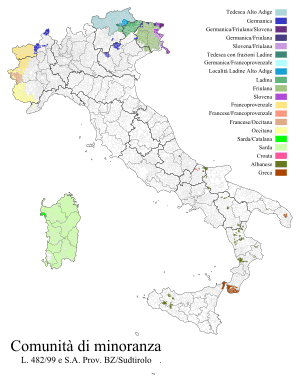
The Republic safeguards linguistic minorities by means of appropriate measures.
— Italian Constitution, Art. 6
The Art. 6 of the Italian Constitution was drafted by the Founding Fathers to show sympathy for the country's historical linguistic minorities, in a way for the newly-founded Republic to let them become part of the national fabric and distance itself from the Italianization policies promoted earlier because of nationalism, especially during Fascism.[20][21][22]
However, more than a half century passed before the Art. 6 was followed by any of the above-mentioned "appropriate measures".[23] Italy applied in fact the Article for the first time in 1999, by means of the national law N.482/99.[8]
Before said legal framework entered into force, only four linguistic minorities (the French-speaking community in the Aosta Valley; the German-speaking community and, to a limited extent, the Ladin one in the Province of Bolzano; the Slovene-speaking community in the Province of Trieste and, with less rights, the Province of Gorizia) enjoyed some kind of acknowledgment and protection, stemming from specific clauses within international treaties.[20] The other eight linguistic minorities were to be recognized only in 1999, including the Slovene-speaking minority in the Province of Udine and the Germanic populations (Walser, Mocheni and Cimbri) residing in provinces different from Bolzano. Some now-recognized minority groups, namely in Friuli-Venezia Giulia and Sardinia, already provided themselves with regional laws of their own. It has been estimated that less than 400.000 people, out of the two million people belonging to the twelve historical minorities (with Sardinian being the numerically biggest one[24][25][26]), enjoyed state-wide protection.[27]
Around the 1960s, the Italian Parliament eventually resolved to apply the previously neglected article of the country's fundamental Charter. The Parliament thus appointed a "Committee of three Sages" to single out the groups that were to be recognized as linguistic minorities, and further elaborate the reason for their inclusion. The nominated people were Tullio de Mauro, Giovan Battista Pellegrini and Alessandro Pizzorusso, three notable figures who distinguished themselves with their life-long activity of research in the field of both linguistics and legal theory. Based on linguistic, historical as well as anthropological considerations, the experts eventually selected thirteen groups, corresponding to the currently recognized twelve with the further addition of the Sinti and Romani-speaking populations.[28] The original list was approved, with the only exception of the nomadic peoples, who lacked the territoriality requisite and therefore needed a separate law. However, the draft was presented to the law-making bodies when the legislature was about to run its course, and had to be passed another time. The bill was met with resistance by all the subsequent legislatures, being reluctant to challenge the widely-held myth of "Italian linguistic homogeneity",[23] and only in 1999 did it eventually pass, becoming a law. In the end, the historical linguistic minorities have been recognized by the Law no. 482/1999 (Legge 15 Dicembre 1999, n. 482, Art. 2, comma 1).[8][29]
Some interpretations of said law seem to divide the twelve minority languages into two groups, with the first including the non-Latin speaking populations (with the exception of the Catalan-speaking one) and the second including only the Romance-speaking populations. Some other interpretations state that a further distinction is implied, considering only some groups to be "national minorities".[23][30] Regardless of the ambiguous phrasing, all the twelve groups are technically supposed to be allowed the same measures of protection;[31] furthermore, the Framework Convention for the Protection of National Minorities, signed and ratified by Italy in 1997, applies to all the twelve groups mentioned by the 1999 national law, therefore including the Friulians, the Sardinians,[32][33][34] the Occitans, the Ladins etc., with the addition of the Romani.
In actual practice, not each of the twelve historical linguistic minorities is given the same consideration.[23] In fact, the discrimination lies in the urgent need to award the highest degree of protection only to the French-speaking minority in the Aosta Valley and the German one in South Tyrol, owing to international treaties.[35] For example, the institutional websites are only in Italian with a few exceptions, like a French version of the Italian Chamber of Deputies.[36] A bill proposed by former prime minister Mario Monti's cabinet formally introduced a differential treatment between the twelve historical linguistic minorities, distinguishing between those with a "foreign mother tongue" (the groups protected by agreements with Austria, France and Slovenia) and those with a "peculiar dialect" (all the others). The bill was later implemented, but deemed unconstitutional by the Constitutional Court.[37][38]
Recognition at the European level
Italy is a signatory of the European Charter for Regional or Minority Languages, but has not ratified the treaty, and therefore its provisions protecting regional languages do not apply in the country.[39]
The Charter does not, however, establish at what point differences in expression result in a separate language, deeming it an "often controversial issue", and citing the necessity to take into account, other than purely linguistic criteria, also "psychological, sociological and political considerations".[40]
Regional recognition of the local languages
- Aosta Valley:
- French is co-official (enjoying the same dignity and standing of Italian) in the whole region (Le Statut spécial de la Vallée d'Aoste, Title VIe, Article 38);[41]
- Franco-Provencal is unofficial, but protected and promoted according to federal and regional laws.[41][42]
- German is unofficial but recognised in the Lys Valley (Lystal) (Le Statut spécial de la Vallée d'Aoste, Title VIe, Art. 40 - bis).[41]
- Apulia:
- Griko, Arbëresh and Franco-Provençal are recognized and safeguarded (Legge regionale 5/2012).[43]
- Friuli-Venezia Giulia:
- Lombardy:
- Piedmont:
- Piedmontese is unofficial but recognised as the regional language (Consiglio Regionale del Piemonte, Ordine del Giorno n. 1118, Presentato il 30 November 1999);[47][48]
- the region "promotes", without recognising, the Occitan, Franco-Provençal, French and Walser languages (Legge regionale 7 aprile 2009, n. 11, Art. 1).[49]
- Sardinia:
- The region considers the cultural identity of the Sardinian people as a primary asset (l.r. N.26/97,[50] l.r. N.22/18[51]), in accordance with the values of equality and linguistic pluralism enshrined in the Italian Constitution and the European treaties, with particular reference to the European Charter for Regional or Minority Languages and the Framework Convention for the Protection of National Minorities (l.r. N.26/97).[50] All the languages indigenous to the island (Sardinian, Catalan, Tabarchino, Sassarese and Gallurese) are recognised and promoted as "enjoying the same dignity and standing of Italian" (l.r. N.26/97)[50] in their respective linguistic areas.
- Sicily:
- South Tyrol:
- Trentino:
- Veneto:
Conservation status
.svg.png)
According to the UNESCO's Atlas of the World's Languages in Danger, there are 31 endangered languages in Italy.[55] The degree of endangerment is classified in different categories ranging from 'safe' (safe languages are not included in the atlas) to 'extinct' (when there are no speakers left).[56]
The source for the languages' distribution is the Atlas of the World's Languages in Danger[55] unless otherwise stated, and refers to Italy exclusively.
Vulnerable
- Alemannic: spoken in the Lys Valley of the Aosta Valley and in Northern Piedmont
- Bavarian: South Tyrol
- Ladin: several valleys, comunes and villages in the Dolomites, including the Val Badia and the Gardena Valley in South Tyrol, the Fascia Valley in Trentino, and Livinallongo in the Province of Belluno
- Sicilian: Sicily, southern and central Calabria and southern Apulia
- Neapolitan: Campania, Basilicata, Abruzzo, Molise, northern Calabria, northern and central Apulia, southern Lazio and Marche as well as eastern fringes of Umbria
- Romanesco: Metropolitan City of Rome in Lazio and in some comunes of southern Tuscany
- Venetian: Veneto, parts of Friuli-Venezia Giulia
Definitely endangered
- Algherese Catalan: the town of Alghero in northwestern Sardinia; an outlying dialect of Catalan language not listed separately by the SIL
- Alpine Provençal: the upper valleys of Piedmont (Val Mairo, Val Varacho, Val d'Esturo, Entraigas, Limoun, Vinai, Pinerolo, Sestrieres); the original joint ISO code [prv] for Alpine Provençal and Provençal has been retired on false grounds.
- Arbëresh: (i) Adriatic zone: Montecilfone, Campomarino, Portocannone and Ururi in Molise as well as Chieuti and Casalvecchio di Puglia in Apulia; (ii) San Marzano in Apulia; (iii) Greci in Campania; (iv) northern Basilicata: Barile, Ginestra and Maschito; (v) North Calabrian zone: ca. 30 settlements in northern Calabria (Plataci, Civita, Frascineto, San Demetrio Corone, Lungro, Acquaformosa etc.) as well as San Costantino Albanese and San Paolo Lucano in southern Basilicata; (vi) settlements in southern Calabria, e.g. San Nicola dell'Alto and Vena di Maida; (vii) Sicilian zone: Piana degli Albanesi and two nearby villages near Palermo; (viii) formerly also Villabadessa in Abruzzi; an outlying dialect of Albanian
- Cimbrian: vigorously spoken in Luserna in Trentino; disappearing in Giazza (part of the commune Selva di Progno) in the Province of Verona and in Roana in the Province of Vicenza; recently extinct in several other locations in the region; an outlying dialect of Bavarian
- Corsican: spoken on Maddalena Island off the northeast coast of Sardinia
- Emilian-Romagnol: Emilia-Romagna, parts of the provinces of Pavia, Voghera, and Mantua in southern Lombardy, the Lunigiana district in northwestern Tuscany, the Alta Valle del Tevere district in northern part of the Province of Perugia and eastern part of the Province of Arezzo, the Province of Pesaro-Urbino in the Marche, and in a zone called Traspadana Ferrarese in the Province of Rovigo in Veneto
- Faetar: Faeto and Celle San Vito in the Province of Foggia in Apulia; an outlying dialect of Francoprovençal not listed separately by the SIL
- Franco-Provençal: spoken in the Aosta Valley (Valdotain dialect) and the Alpine valleys to the north and east of the Susa Valley in Piedmont
- Friulian: Friuli-Venezia Giulia except the Province of Trieste and western and eastern border regions, and Portogruaro area in the Province of Venice in Veneto
- Gallo-Italic of Sicily: Nicosia, Sperlinga, Piazza Armerina, Valguarnera Caropepe and Aidone in the province of Enna, and San Fratello, Acquedolci, San Piero Patti, Montalbano Elicona, Novara di Sicilia and Fondachelli-Fantina in the province of Messina; an outlying dialect of Lombard not listed separately by the SIL; other dialects were formerly also spoken in southern Italy outside Sicily, especially in Basilicata
- Gallurese: northeastern Sardinia; an outlying dialect of Corsican
- Ligurian: Liguria and adjacent areas of Piedmont, Emilia and Tuscany; settlements in the towns of Carloforte on the San Pietro Island and Calasetta on the Sant'Antioco Island off the southwest coast of Sardinia
- Lombard: Lombardy (except the southernmost border areas) and the Province of Novara in Piedmont
- Mòcheno: Palù, Fierozzo and Frassilongo in the Fersina Valley in Trentino; an outlying dialect of Bavarian
- Piedmontese: Piedmont except the Province of Novara, the western Alpine valleys and southern border areas, as well as minor adjacent areas
- Resian: Resia in the northeastern part of the Province of Udine; an outlying dialect of Slovene not listed separately by the SIL
- Romani: spoken by the Roma community in Italy
- Sardinian, consisting of both the Campidanese (southern Sardinia) and Logudorese (central Sardinia) dialects
- Sassarese: northwestern Sardinia; a transitional language between Corsican and Sardinian
- Yiddish: spoken by parts of the Jewish community in Italy
Severely endangered
- Walser German: the village of Issime in the upper Lys Valley/Lystal in the Aosta Valley; an outlying dialect of Alemannic not listed separately by the SIL
- Molise Croatian: the villages of Montemitro, San Felice del Molise, and Acquaviva Collecroce in the Province of Campobasso in southern Molise;[57] a mixed Chakavian–Shtokavian dialect of Serbo-Croatian not listed separately by the SIL
- Griko (Salento): the Salento peninsula in the Province of Lecce in southern Apulia; an outlying dialect of Greek not listed separately by the SIL
- Gardiol: Guardia Piemontese in Calabria; an outlying dialect of Alpine Provençal
- Griko (Calabria): a few villages near Reggio di Calabria in southern Calabria; an outlying dialect of Greek not listed separately by the SIL.
Classification
All living languages indigenous to Italy are part of the Indo-European language family.
They can be divided into Romance languages and non-Romance languages. The classification of the Romance languages of Italy is controversial, and we report here two different classification systems.
Romance languages (Ethnologue)
The source is the SIL's Ethnologue unless otherwise stated.[58] Language classification can be a controversial issue, when a classification is contested by academic sources, this is reported in the 'notes' column.
Gallo-Rhaetian and Occitano-Romance
| Language | Family | ISO 639-3 | Dialects spoken in Italy | Notes | Speakers | |||
|---|---|---|---|---|---|---|---|---|
| French (français) | Gallo-Romance | Gallo-Rhaetian | Oïl | French | fra | 100,000 | ||
| Arpitan (franco-provençal) | Gallo-Romance | Gallo-Rhaetian | Oïl | South-Eastern | frp | 70,000 | ||
| Friulian (furlan) | Gallo-Romance | Gallo-Rhaetian | Rhaetian | Friulian | fur | 600,000[59] | ||
| Ladin (lingaz ladin) | Gallo-Romance | Gallo-Rhaetian | Rhaetian | Ladin | lld | 31,000 | ||
| Catalan (català) | Gallo-Romance | Occitano-Romance or Ibero-Romance | cat | Algherese | 20,000 | |||
| Occitan (lenga d'òc) | Gallo-Romance | Occitano-Romance | oci | Provençal; Gardiol | 100,000 | |||
Gallo-Italic languages
| Language | ISO 639-3 | Dialects spoken in Italy | Notes | Speakers |
|---|---|---|---|---|
| Emiliano-Romagnolo (emiliân-rumagnōl) | eml | Emilian; Romagnol (Forlivese); | Emilian and Romagnol have been assigned two different ISO 639-3 codes (egl and rgn, respectively). | 1,000,000 |
| Ligurian (ligure) | lij | Genoese; Spezzino; Monegàsco; Intemelio; Brigasc; Royasc; Tabarchino; Bonifacino; Novéize | 500,000 | |
| Lombard (lumbàart) | lmo | Western Lombard (see Western dialects of Lombard language, such as Milanese); Eastern Lombard; Gallo-Italic of Sicily | 3,600,000 | |
| Piedmontese (piemontèis) | pms | Piedmontese varieties; Judeo-Piedmontese | 1,600,000 | |
| Venetian (vèneto) | vec | Triestine; Fiuman; Chipilo Venetian; Talian; veneziano Lagunar | Grouped with either Gallo-Italic or Italo-Dalmatian | 3,800,000 |
Italo-Dalmatian languages
Not included is Corsican, which is mainly spoken on the French island of Corsica. Istriot is only spoken in Croatia. Judeo-Italian is moribund.
| Language | ISO 639-3 | Dialects spoken in Italy | Notes | Speakers |
|---|---|---|---|---|
| Italian (italiano) | ita | Tuscan; | National language | 60,000,000 |
| Central Italian (italiano centrale) | ita | Romanesco; Sabino; Marchigiano | 5,700,000 | |
| Neapolitan (napulitano) | nap | Abruzzese; Cosentino; Bari dialect | 3,000,000 | |
| Sicilian (sicilianu) | scn | Salentino; Southern Calabrian | 4,700,000 |
Sardinian language
Sardinian (sardu) is a distinct language with significant phonological differences among its own varieties (Ethnologue assigns it four separate ISO codes).[60] Some linguists, like Heinrich Lausberg, proposed that Sardinian is the sole living representative its branch of the Romance languages, which used to comprise the now extinct Afro-Romance dialects as well as the Corsican dialects before they underwent Tuscanization. UNESCO, while calling Gallurese and Sassarese "Sardinian",[55] considers them to be originally dialects of Corsican rather than Sardinian.[55] The linguistic landscape of Sardinia is in principle most accurately described as being a dialect continuum.
| Language | ISO 639-3 | Dialects spoken in Italy | Notes | Speakers |
|---|---|---|---|---|
| Campidanese Sardinian (sardu campidanesu) | sro | Orthographic model of the central southern Sardinian dialects | 500,000 | |
| Logudorese Sardinian (sardu logudoresu) | src | Orthographic model of the central northern Sardinian dialects | 500,000 | |
| Gallurese Sardinian (gadduresu) | sdn | Outlying dialect of Corsican, sometimes considered part of Sardinian | 100,000 | |
| Sassarese Sardinian (sassaresu) | sdc | Outlying dialect of Corsican, sometimes considered part of Sardinian | 100,000 |
Romance languages (Loporcaro)
Loporcaro 2009 proposes a classification of Romance languages of Italy based on Pellegrini 1977, who groups different Romance languages according to areal and some typological features. The following five linguistic areas can be identified:[61]
- Northern varieties (dialetti settentrionali):
- Gallo-Italic (Emilian, Piedmontese, Lombard, and Ligurian).
- Venetian.
- Friulian varieties.
- Tuscan varieties.
- Mid-Southern varieties (dialetti centro-meridionali):
- Middle (dialetti mediani; Central Marchigiano, Umbrian, Laziale).
- Upper Southern (dialetti alto-meridionali; Marchigiano-Abruzzese, Molisano, Apulian, Southern Laziale and Campidanian including Neapolitan, Northern Lucano-Calabrese).
- Extreme Southern (dialetti meridionali estremi; Salentino, Calabrian, Sicilian).
- Sardinian varieties.
Romance languages (Maiden and Parry)
The following classification is proposed by Maiden 1997:
- Northern varieties:
- Northern Italo-Romance:
- 'Gallo-Italian' (Piedmont, Lombardy, Liguria and Emilia-Romagna).
- Venetan.
- Ladin.
- Friulian.
- Northern Italo-Romance:
- Central and Southern varieties:
- Tuscan (with Corsican).
- 'Middle Italian' dialects (Marche, Umbria, Lazio).
- Upper southern dialects (Abruzzo, northern Puglia, Molise, Campania, Basilicata).
- Extreme southern dialects (Salento, southern Calabria and Sicily).
- Sardinian.
Non-Romance languages
Albanian, Slavic, Greek and Romani languages
| Language | Family | ISO 639-3 | Dialects spoken in Italy | Notes | Speakers | |||
|---|---|---|---|---|---|---|---|---|
| Arbëresh | Albanian | Tosk | aae | considered an outlying dialect of Albanian by the UNESCO[55] | 100,000 | |||
| Serbo-Croatian | Slavic | South | Western | hbs | Molise Croatian | 1,000 | ||
| Slovene (slovenščina) | Slavic | South | Western | slv | Gai Valley dialect; Resian; Torre Valley dialect; Natisone Valley dialect; Brda dialect; Karst dialect; Inner Carniolan dialect; Istrian dialect | 100,000 | ||
| Italiot Greek | Hellenic (Greek) | Attic | ell | Griko (Salento); Calabrian Greek | 20,000 | |||
| Romani | Indo-Iranian | Indo-Aryan | Central Zone | Romani | rom | |||
High German languages
| Language | Family | ISO 639-3 | Dialects spoken in Italy | Notes | Speakers | |
|---|---|---|---|---|---|---|
| German | Middle German | East Middle German | deu | Tyrolean dialects | Austrian German is the usual standard variety | 315,000 |
| Cimbrian | Upper German | Bavarian-Austrian | cim | sometimes considered a dialect of Bavarian, also considered an outlying dialect of Bavarian by the UNESCO[55] | 2,200 | |
| Mocheno | Upper German | Bavarian-Austrian | mhn | considered an outlying dialect of Bavarian by the UNESCO[55] | 1,000 | |
| Walser | Upper German | Alemannic | wae | 3,400 | ||
Geographic distribution
Northern Italy
The Northern Italian languages are conventionally defined as those Romance languages spoken north of the La Spezia–Rimini Line, which runs through the northern Apennine Mountains just to the north of Tuscany; however, the dialects of Occitan and Franco-Provençal spoken in the extreme northwest of Italy (e.g. the Valdôtain in the Aosta Valley) are generally excluded. The classification of these languages is difficult and not agreed-upon, due both to the variations among the languages and to the fact that they share isoglosses of various sorts with both the Italo-Romance languages to the south and the Gallo-Romance languages to the northwest.
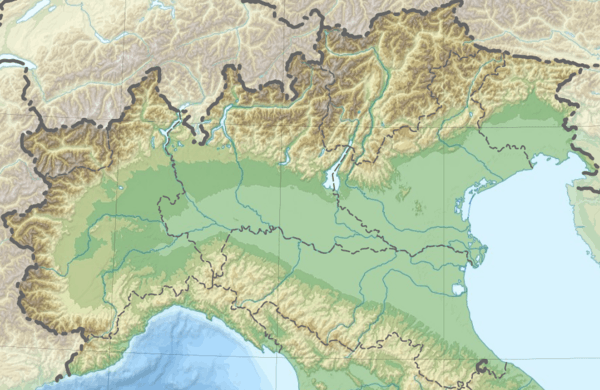
Provençal
One common classification divides these languages into four groups:
- The Italian Rhaeto-Romance languages, including Ladin and Friulan.
- The poorly researched Istriot language.
- The Venetian language (sometimes grouped with the majority Gallo-Italian languages).
- The Gallo-Italian languages, including all the rest (although with some doubt regarding the position of Ligurian).
Any such classification runs into the basic problem that there is a dialect continuum throughout northern Italy, with a continuous transition of spoken dialects between e.g. Venetian and Ladin, or Venetian and Emilio-Romagnolo (usually considered Gallo-Italian).
All of these languages are considered innovative relative to the Romance languages as a whole, with some of the Gallo-Italian languages having phonological changes nearly as extreme as standard French (usually considered the most phonologically innovative of the Romance languages). This distinguishes them significantly from standard Italian, which is extremely conservative in its phonology (and notably conservative in its morphology).[62]
Southern Italy and islands
Approximate distribution of the regional languages of Sardinia and Southern Italy according to the UNESCO's Atlas of the World's Languages in Danger:
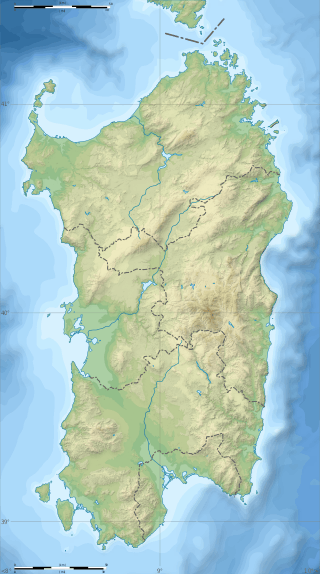
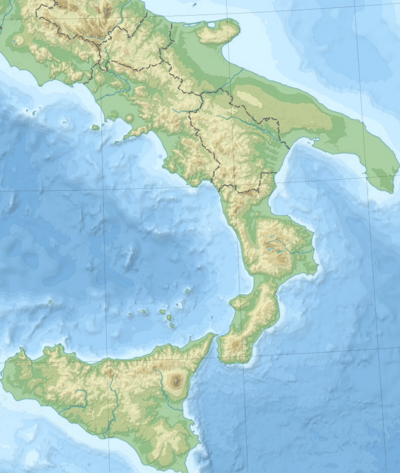
One common classification divides these languages into two groups:
- The Italo-Dalmatian languages, including Neapolitan and Sicilian, as well as the Sardinian-influenced Sassarese and Gallurese which are sometimes grouped with Sardinian but are actually of southern Corsican origin.
- The Sardinian language, usually listed as a group of its own with two main Logudorese and Campidanese orthographic forms.
All of these languages are considered conservative relative to the Romance languages as a whole, with Sardinian being the most conservative of them all.
Mother-tongues of foreigners
| Language (2012)[63][64] | Population |
|---|---|
| Romanian | 798,364 |
| Arabic | 476,721 |
| Albanian | 380,361 |
| Spanish | 255,459 |
| Italian | 162,148 |
| Chinese | 159,597 |
| Russian | 126,849 |
| Ukrainian | 119,883 |
| French | 116,287 |
| Bosnian-Croatian-Montenegrin-Serbian | 93,289 |
| Polish | 87,283 |
| Others | 862,986 |
Standardised written forms
Although "[al]most all Italian dialects were being written in the Middle Ages, for administrative, religious, and often artistic purposes,"[65] use of local language gave way to stylized Tuscan, eventually labeled Italian. Local languages are still occasionally written, but only the following regional languages of Italy have a standardised written form. This may be widely accepted or used alongside more traditional written forms:
- Piedmontese: traditional, definitely codified between the 1920s and the 1960s by Pinin Pacòt and Camillo Brero
- Ligurian: "Grafîa ofiçiâ" created by the Académia Ligùstica do Brénno;[66]
- Sardinian: "Limba sarda comuna" was experimentally adopted in 2006;[67]
- Friulian: "Grafie uficiâl" created by the Osservatori Regjonâl de Lenghe e de Culture Furlanis;[68]
- Ladin: "Grafia Ladina" created by the Istituto Ladin de la Dolomites;[69]
- Venetian: "Grafia Veneta Unitaria", the official manual published in 1995 by the Regione Veneto local government, although written in Italian.[70] It has been recently updated on 14 December 2017, under the name of "Grafia Veneta Ufficiale".[71]
Gallery
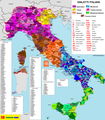 Detailed map of the languages and dialects in Italy, net of the recognised ethno-linguistic minorities
Detailed map of the languages and dialects in Italy, net of the recognised ethno-linguistic minorities Officially recognised ethno-linguistic minorities of Italy
Officially recognised ethno-linguistic minorities of Italy Regional languages of Italy according to Clemente Merlo and Carlo Tagliavini in 1939
Regional languages of Italy according to Clemente Merlo and Carlo Tagliavini in 1939 Languages and language islands of Italy
Languages and language islands of Italy Languages of Italy
Languages of Italy Main dialectal groups of Italy
Main dialectal groups of Italy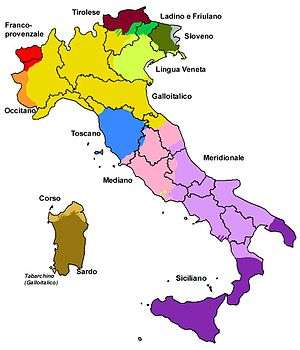 Main linguistic groups of Italy
Main linguistic groups of Italy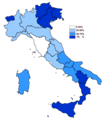 Percentage of people in Italy having a command of a regional language (Doxa, 1982; Coveri's data, 1984)
Percentage of people in Italy having a command of a regional language (Doxa, 1982; Coveri's data, 1984)
Notes
- Tagliavini, Carlo (1962). Le origini delle lingue neolatine: introduzione alla filologia romanza. R. Patròn.
- "La variazione diatopica". Archived from the original on February 2012.
- Archived 7 November 2005 at the Wayback Machine
- AIS, Sprach-und Sachatlas Italiens und der Südschweiz, Zofingen 1928-1940
- https://www.tuttitalia.it/statistiche/cittadini-stranieri-2018/
- "Italy". Ethnologue. Retrieved 22 July 2017.
- "Legge 482". Camera.it. Retrieved 17 October 2015.
- Norme in materia di tutela delle minoranze linguistiche storiche, Italian parliament, retrieved 17 October 2015
- Loporcaro 2009; Marcato 2007; Posner 1996; Repetti 2000:1–2; Cravens 2014.
- Cravens 2014
- Domenico Cerrato. "Che lingua parla un italiano?". Treccani.it.
- Tullio, de Mauro (2014). Storia linguistica dell'Italia repubblicana: dal 1946 ai nostri giorni. Editori Laterza, ISBN 9788858113622
- Maiden, Martin; Parry, Mair (7 March 2006). The Dialects of Italy. Routledge. p. 2. ISBN 9781134834365.
- Repetti, Lori (2000). Phonological Theory and the Dialects of Italy. John Benjamins Publishing. ISBN 9027237190. Retrieved 3 November 2015.
- Andreose, Alvise; Renzi, Lorenzo (2013), "Geography and distribution of the Romance Languages in Europe", in Maiden, Martin; Smith, John Charles; Ledgeway, Adam (eds.), The Cambridge History of the Romance Languages, Vol. 2, Contexts, Cambridge: Cambridge University Press, pp. 302–308
- Bonamore, Daniele (2006). Lingue minoritarie Lingue nazionali Lingue ufficiali nella legge 482/1999, Editore Franco Angeli, p.16
- Michele Salazar (Università di Messina, Direttore Rivista giuridica della scuola) - Presentazione: (…) La spiegazione datane nell'opera sotto analisi appare nuova e convincente (…) il siciliano (…) il bolognese (…) l'umbro (…) il toscano (…) hanno fatto l'italiano, sono l'italiano - Bonamore, Daniele (2008). Lingue minoritarie Lingue nazionali Lingue ufficiali nella legge 482/1999, Editore Franco Angeli
- "Legge 482". Webcitation.org. Archived from the original on 24 September 2015. Retrieved 17 October 2015.
- "Lingue di Minoranza e Scuola: Carta Generale". Minoranze-linguistiche-scuola.it. Archived from the original on 10 October 2017. Retrieved 8 October 2017.
- "Tutela delle minoranze linguistiche e articolo 6 Costituzione".
- "Articolo 6 Costituzione, Dispositivo e Spiegazione".
- Paolo Coluzzi (2007). Minority Language Planning and Micronationalism in Italy: An Analysis of the Situation of Friulian, Cimbrian and Western Lombard with Reference to Spanish Minority Languages. Peter Lang. p. 97.
- "Schiavi Fachin, Silvana. Articolo 6, Lingue da tutelare".
- "Lingue di Minoranza e Scuola, Sardo". Archived from the original on 16 October 2018. Retrieved 12 January 2019.
- "Inchiesta ISTAT 2000, pg.105-107" (PDF).
- "What Languages are Spoken in Italy?".
- Salvi, Sergio (1975). Le lingue tagliate. Storia della minoranze linguistiche in Italia, Rizzoli Editore, pp. 12–14
- Camera dei deputati, Servizio Studi, Documentazione per le Commissioni Parlamentari, Proposte di legge della VII Legislatura e dibattito dottrinario,123/II, marzo 1982
- "Italy's general legislation, Language Laws".
- Archived 16 May 2012 at the Wayback Machine
- Bonamore, Daniele (2008). Lingue minoritarie lingue nazionali lingue ufficiali nella legge 482/1999, FrancoAngeli Editore, Milano, p. 29
- "Lingua Sarda, Legislazione Internazionale, Sardegna Cultura".
- "Coordinamentu sardu ufitziale, lettera a Consiglio d'Europa: "Rispettare impegni"".
- "Il Consiglio d'Europa: "Lingua sarda discriminata, norme non-rispettate"".
- See the appeal of the attorney Felice Besostri against the Italian electoral law of 2015.
- "Chambre des députés".
- "Sentenza Corte costituzionale nr. 215 del 3 luglio 2013, depositata il 18 luglio 2013 su ricorso della regione Friuli-VG".
- "Anche per la Consulta i friulani non-sono una minoranza di serie B" (PDF).
- "Chart of signatures and ratifications of Treaty 148". Council of Europe. Archived from the original on 17 October 2015. Retrieved 17 October 2015.
- What is a regional or minority language?, Council of Europe, retrieved 17 October 2015
- Statut spécial de la Vallée d'Aoste, Title VIe, Region Vallée d'Aoste, retrieved 17 October 2015
- "Conseil de la Vallée - Loi régionale 1er août 2005, n. 18 - Texte en vigueur". Retrieved 25 April 2020
- Puglia, QUIregione - Il Sito web Istituzionale della Regione. "QUIregione - Il Sito web Istituzionale della Regione Puglia". QUIregione - Il Sito web Istituzionale della Regione Puglia. Retrieved 10 June 2018.
- Norme per la tutela, valorizzazione e promozione della lingua friulana, Regione Autonoma Friuli Venezia Giulia, retrieved 17 October 2015
- Norme regionali per la tutela della minoranza linguistica slovena, Regione Autonoma Friuli Venezia Giulia, retrieved 17 October 2015
- "L.R. 25/2016 - 1. Ai fini della presente legge, la Regione promuove la rivitalizzazione, la valorizzazione e la diffusione di tutte le varietà locali della lingua lombarda, in quanto significative espressioni del patrimonio culturale immateriale, attraverso: a) lo svolgimento di attività e incontri finalizzati a diffonderne la conoscenza e l'uso; b) la creazione artistica; c) la diffusione di libri e pubblicazioni, l'organizzazione di specifiche sezioni nelle biblioteche pubbliche di enti locali o di interesse locale; d) programmi editoriali e radiotelevisivi; e) indagini e ricerche sui toponimi. 2. La Regione valorizza e promuove tutte le forme di espressione artistica del patrimonio storico linguistico quali il teatro tradizionale e moderno in lingua lombarda, la musica popolare lombarda, il teatro di marionette e burattini, la poesia, la prosa letteraria e il cinema. 3. La Regione promuove, anche in collaborazione con le università della Lombardia, gli istituti di ricerca, gli enti del sistema regionale e altri qualificati soggetti culturali pubblici e privati, la ricerca scientifica sul patrimonio linguistico storico della Lombardia, incentivando in particolare: a) tutte le attività necessarie a favorire la diffusione della lingua lombarda nella comunicazione contemporanea, anche attraverso l'inserimento di neologismi lessicali, l'armonizzazione e la codifica di un sistema di trascrizione; b) l'attività di archiviazione e digitalizzazione; c) la realizzazione, anche mediante concorsi e borse di studio, di opere e testi letterari, tecnici e scientifici, nonché la traduzione di testi in lingua lombarda e la loro diffusione in formato digitale."
- Ordine del Giorno n. 1118, Presentato il 30/11/1999, Consiglio Regionale del Piemonte, retrieved 17 October 2015
- Ordine del Giorno n. 1118, Presentato il 30/11/1999 (PDF), Gioventura Piemontèisa, retrieved 17 October 2015
- Legge regionale 7 aprile 2009, n. 11. (Testo coordinato) "Valorizzazione e promozione della conoscenza del patrimonio linguistico e culturale del Piemonte", Consilio Regionale del Piemonte, retrieved 2 December 2017
- "Legge Regionale 15 ottobre 1997, n. 26". Regione autonoma della Sardegna – Regione Autònoma de Sardigna.
- "Legge Regionale 3 Luglio 2018, n. 22". Regione autonoma della Sardegna – Regione Autònoma de Sardigna.
- Gazzetta Ufficiale della Regione Siciliana - Anno 65° - Numero 24
- Statuto speciale per il Trentino-Alto Adige (PDF), Regione.taa.it, retrieved 17 October 2015
- Legge regionale 13 aprile 2007, n. 8, Consiglio Regionale del Veneto, retrieved 17 October 2015
- Interactive Atlas of the World's Languages in Danger, UNESCO's Endangered Languages Programme, retrieved 17 October 2015
- Degrees of endangerment, UNESCO's Endangered Languages Programme, retrieved 17 October 2015
- "Endangered languages in Europe: report". Helsinki.fi. Retrieved 17 October 2015.
- Languages of Italy, SIL, retrieved 17 October 2015
- "Sociolinguistic Condition". Arlef.it. Retrieved 8 October 2017.
- "Ethnologue report for Southern Romance". Ethnologue.com. Retrieved 17 October 2015.
- Note that Loporcaro uses the term dialetto 'dialect' throughout the book, intended as 'non-national language'. Since dialect has a different connotation in English, the more neutral term variety is used here.
- Hull, Geoffrey, PhD thesis 1982 (University of Sydney), published as The Linguistic Unity of Northern Italy and Rhaetia: Historical Grammar of the Padanian Language. 2 vols. Sydney: Beta Crucis, 2017.
- "Linguistic diversity among foreign citizens in Italy". Statistics of Italy. 25 July 2014. Retrieved 1 April 2015.
- "Stranieri residenti e condizioni di vita : Lingua madre". Istat.it. Retrieved 30 July 2018.
- Andreose, Alvise; Renzi, Lorenzo (2013), "Geography and distribution of the Romance Languages in Europe", in Maiden, Martin; Smith, John Charles; Ledgeway, Adam (eds.), The Cambridge History of the Romance Languages, Vol. 2, Contexts, Cambridge: Cambridge University Press, p. 303
- Grafîa ofiçiâ, Académia Ligùstica do Brénno, retrieved 17 October 2015
- Limba sarda comuna, Sardegna Cultura, retrieved 17 October 2015
- Grafie dal O.L.F., Friûl.net, retrieved 17 October 2015
- PUBLICAZIOIGN DEL ISTITUTO LADIN, Istituto Ladin de la Dolomites, retrieved 17 October 2015
- Grafia Veneta Unitaria - Manuale a cura della giunta regionale del Veneto, Commissione regionale per la grafia veneta unitaria, retrieved 6 December 2016
- "Grafia Veneta ufficiale – Lingua Veneta The modern international manual of the Venetian spelling". Lingua Veneta. Retrieved 20 June 2019.
References
- Cravens, Thomas D. (2014). "Italia Linguistica and the European Charter for Regional or Minority Languages". Forum Italicum. 48: 202–218.CS1 maint: ref=harv (link)
- Loporcaro, Michele (2009). Profilo linguistico dei dialetti italiani (in Italian). Bari: Laterza.CS1 maint: ref=harv (link)
- Maiden, Martin; Parry, Mair (1997). The dialects of Italy. London New York: Routledge.CS1 maint: ref=harv (link)
- Marcato, Carla (2007). Dialetto, dialetti e italiano (in Italian). Bologna: Il Mulino.CS1 maint: ref=harv (link)
- Posner, Rebecca (1996). The Romance languages. Cambridge: Cambridge University Press.CS1 maint: ref=harv (link)
- Pellegrini, Giovan Battista (1977). Carta dei dialetti d'Italia (in Italian). Pisa: Pacini.CS1 maint: ref=harv (link)
- Rapetti, Lori, ed. (2000). Phonological theory and the dialects of Italy. Amsterdam Studies in the Theory and History of Linguistic Science, Series IV Current Issues in Linguistic Theory. 212. Amsterdam/Philadelphia: John Benjamins Publishing.CS1 maint: ref=harv (link)
External links
- NavigAIS Online version of the Sprach- und Sachatlas Italiens und der Südschweiz (AIS) (Linguistic and Ethnographic Atlas of Italy and Southern Switzerland)
- An interactive map of languages and dialects in Italy
- Ethnologue - Languages of Italy
- Rivista Etnie, linguistica
